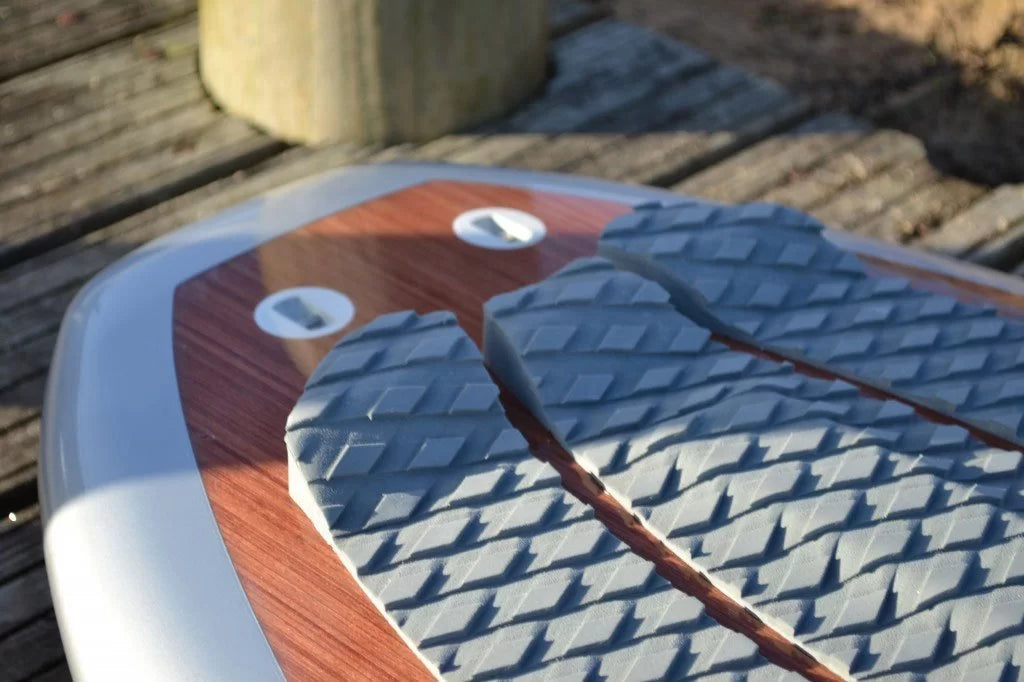Top 5 Surf SUP Buying Advice Tips

Top 5 Surf SUP Buying Advice Tips
1) Don’t go too small too soon. Although there is an obsession with using the smallest board possible at the performance end of competition paddle surfing is this really the right way to go for your average intermediate? This type of board affords the rider very little volume (float), can be very tricky to balance on in any kind of chop, suffers from minimal glide which often translates into lots of scratching versus maximising your wave count.
As a general rule think about multiplying your body weight by 1.5 so if you’re 80kg you ‘should’ be able to paddle a 120L surf sup. That said other factors do come into play. Width is a key element. If you’re light (<65kg) then you should be able to get away with a board of circa 27-28.5” wide, for the majority (75-90kg) 28.5-30.5” is a good place to start and for the heavier paddler we’d recommend 30-33” although a lot will be governed by balance and ability.
2) Match your board to your style of surfing and prevailing conditions. Top 5 Surf SUP Buying Advice Tips - If you only get slow powerless waves at your local break there’s little point having an aggressive surf shape as the board won’t work in those kind of conditions. You’d be much better off with a longer more voluminous stick that can pick up the slightest ripple.
If you’re home spot gets lovely pealing glassy conditions but at the expense of offshore wind is a feather-light carbon board really the best option? You’ll struggle to drop in on a super light board unless you can effectively cross step to the nose and force the issue which take a bit of practice. If you favour longboard type surfing you’ll probably feel most at home on a 9’5”-10’6” board where you can still nose ride and cross step around with those old skool type moves. If you’re more radical and want to smack lips and lose the fins then sub 9′ board is going to offer you better carving options.
3) Double Leash Plugs. These come in very handy as you start pushing yourself in larger surf. Until you’ve done the 300m swim of shame back to the beach with a paddle in one hand you can’t appreciate how valuable double leash plugs actually are! Essentially if one cord snaps the other ‘should’ ensure you manage to make it home without too much egg on your face. Always a good idea to check your equipment before each session to make sure leash and attaching cords are in good order.
Credit : Sup Connect / My Local Line UP
4) Check out some reviews and videos of the board(s) in action. We’re not suggesting this should be the be all and end all in terms of parting with your hard earned £££ but its certainly a good place to start! Just because a team rider can make a board rip don’t assume you’ll suddenly turn into Kai Lenny! Also consider the conditions the board was tested or filmed in. Remember European conditions can be fluky so maybe a board developed and tested in Indo/Oz/Hawaii isn’t the best option for your average South Coast 2-3ft tiddler.
5) There’s so many constructions which one should I choose? It’s a tricky one really as there are some brands who offer great shapes but the constructions are a bit snide to hit a price point whereas other more expensive brands’ shapes aren’t as dynamic but they’re relatively bulletproof.
If you’re the type of person who rinses your board in fresh water after every session and meticulously brushes off the last sand particle before it goes back into the board bag then we’d suggest that you’re probably going to be OK with most constructions unless you hit a rock or another water craft. If you’re less careful with your equipment you should probably steer clear of brands offering ‘light finish’ constructions at bargain basement prices.
It is possible to get a board light and strong but the materials involved ‘usually’ necessitate a £800+ price tag. As a general rule have a look at your board of interest’s construction and see how many layers and what grade of fibreglass it has top and bottom.
More fibreglass generally means more weight/strength although we’re seeing some of the more innovative brands including Loco using glass/PVC and wood/glass sandwich constructions to achieve very good weights but not at the expense of strength.
Whichever way you choose to go with your new surf SUP, make sure you get a board that suits your weight, ability, surfing style and prevailing conditions and you’ll ensure you’re getting sectioned as often as possible.




